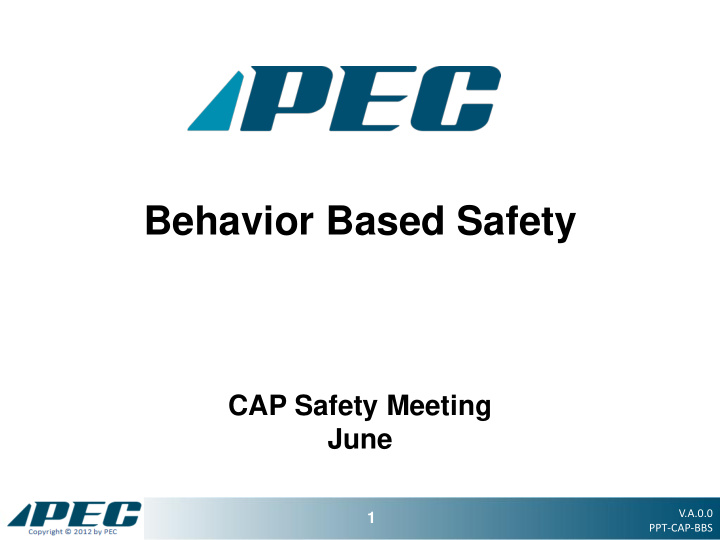



Behavior Based Safety CAP Safety Meeting June V.A.0.0 1 1 PPT-CAP-BBS
Safety is more important than getting the job done. V.A.0.0 2 2 PPT-CAP-BBS
Behavior Based Safety Behavior Based Safety (BBS) helps you identify and choose a safe behavior over an unsafe one. V.A.0.0 3 3 PPT-CAP-BBS
Behavior Based Safety BBS identifies safe behaviors through observation of: Work environment Equipment • Safety measures • Workers Ability • Experience • Training • Behaviors V.A.0.0 4 4 PPT-CAP-BBS
Basic Principles of BBS Provide feedback • Behavior is a cause of accidents • Be proactive • Consequences motivate behavior • Observing is a process • Communicate • Participate • Continual improvement • V.A.0.0 5 5 PPT-CAP-BBS
The ABC Model A ctivator • Triggers behavior B ehavior • What you do C onsequence • Reinforcement or punishment V.A.0.0 6 6 PPT-CAP-BBS
Barriers to Safe Behavior Untrained workers • Unskilled workers • Complacency • Disagreement on safe work practices • Personal choices • Culture • Ineffective management • Inappropriate rewards or consequences • Facilities and equipment • V.A.0.0 7 7 PPT-CAP-BBS
Avoid Complacency Follow safe work practices • Do not take shortcuts • Speak up to prevent unsafe acts • V.A.0.0 8 8 PPT-CAP-BBS
Key Components of BBS • Correct behavior list • Observation process/card • Feedback process • Measurement tools V.A.0.0 9 9 PPT-CAP-BBS
Correct Behavior List Determines the right way to do the job • Reflects PPE, safety equipment, and • other safety factors V.A.0.0 10 10 PPT-CAP-BBS
Observation Process The process to help recognize unsafe acts • and conditions. Six steps to the observation process: • Observe 1. Understand 2. Identify alternative behavior 3. Clarify commitment 4. Obtain agreement 5. Observe to follow up 6. V.A.0.0 11 11 PPT-CAP-BBS
Observation Card Used for reporting unsafe acts and conditions • Recommends ways to improve • Includes options for positive feedback and • follow up information Quick and easy to fill out • V.A.0.0 12 12 PPT-CAP-BBS
V.A.0.0 13 13 PPT-CAP-BBS
Feedback Process Immediately follows the observation • For safe behaviors, feedback must acknowledge or • reinforce it For unsafe behaviors, feedback must identify the cause • and any barriers to doing the job safely Feedback must be positive • Details safer ways to do the job • V.A.0.0 14 14 PPT-CAP-BBS
Measurement tools • Maintains an ongoing process • Involves everyone • Measurement tools include: − Data entry − Performance charts − Observation reports − Specific goals V.A.0.0 15 15 PPT-CAP-BBS
Roles and Responsibilities • Managers • Supervisors • Workers • Safety committees V.A.0.0 16 16 PPT-CAP-BBS
Managers Provide oversight • Understand the process and components • Support supervisors • V.A.0.0 17 17 PPT-CAP-BBS
Supervisors Keep all personal observation data confidential • Ensure no disciplinary action is taken from • observations Provide time for observing and documenting • Review and interpret data • Remove barriers to safe behavior • Make BBS a part of daily operations • V.A.0.0 18 18 PPT-CAP-BBS
Workers Have a positive safety attitude • Participate in BBS training • Participate in safety meetings • Recognize unsafe acts and conditions • Follow rules • Comply with safe work practices • V.A.0.0 19 19 PPT-CAP-BBS
Safety Committees Provide BBS training • Discuss issues and concerns at safety meetings • Use data to develop action plans • Make safety recommendations to management • V.A.0.0 20 20 PPT-CAP-BBS
Remember… The ultimate goal of BBS is to have zero injuries. V.A.0.0 21 21 PPT-CAP-BBS
Recommend
More recommend